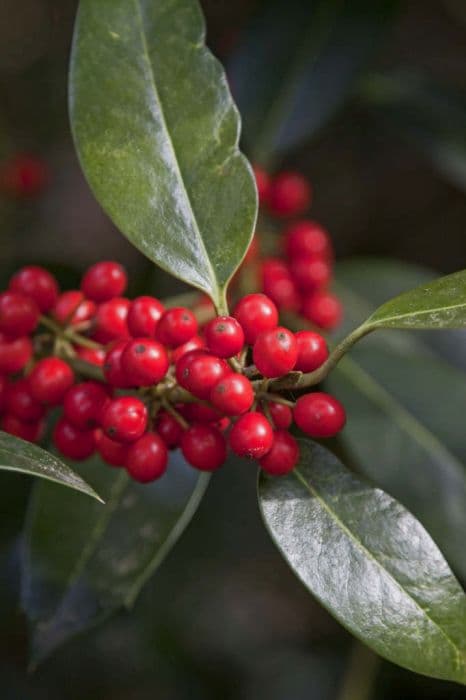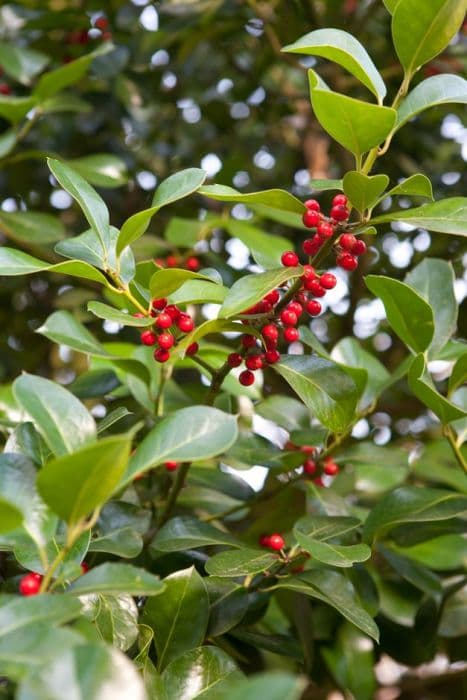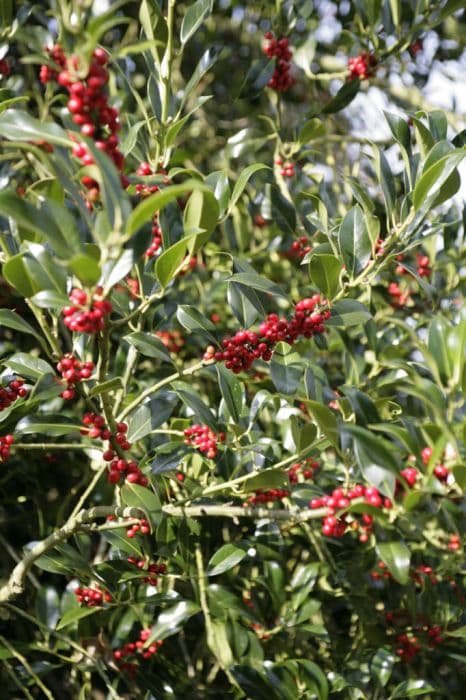English Holly Ilex aquifolium 'Silver Queen' (m/v)

ABOUT
The 'Silver Queen' is an attractive variety of the common holly plant, primarily known for its decorative foliage. The leaves are a glossy, dark green color with creamy-white edges, giving the plant a silver appearance that stands out in any garden setting. Each leaf is characterized by a series of spiny points along the margins, which is a classic trait of holly plants. The contrast between the green centers and the white margins adds visual interest and can provide a sparkling effect when the sunlight catches the edges of the leaves. Adding to its charm, the 'Silver Queen' produces tiny white flowers that are rather inconspicuous compared to the boldness of the foliage. Nonetheless, these flowers add a subtle touch of elegance to the overall appearance of the plant. Since 'Silver Queen' is a male variety, it does not bear the traditional red berries that are often associated with holly plants. Overall, the 'Silver Queen' offers a year-round display of variegated leaves that make it a pleasing ornamental choice for gardens, hedges, or as a standalone specimen. Its distinctive leaf pattern and coloration make it an exceptional choice for those looking to add structure and variegated interest to their landscape design.
About this plant
 Names
NamesFamily
Aquifoliaceae.
Synonyms
Silver Queen Holly, Variegated English Holly.
Common names
Ilex aquifolium 'Silver Queen'
 Toxicity
ToxicityTo humans
The common name of Ilex aquifolium 'Silver Queen' is English Holly. English Holly is considered to be toxic to humans if ingested. The toxicity is due to ilicin, saponins, and other potentially harmful components found in the leaves and berries. Symptoms of poisoning from English Holly can include gastrointestinal upset, such as nausea, vomiting, and diarrhea. Additionally, if a significant quantity of berries is ingested, more severe symptoms may occur, which can include drowsiness, dehydration, and in rare cases, seizures. It is recommended that humans avoid eating any part of the English Holly plant. If ingestion occurs, medical attention should be sought.
To pets
The common name of Ilex aquifolium 'Silver Queen' is English Holly. English Holly is toxic to pets, including dogs and cats. The plant contains saponins and other compounds that can cause vomiting, diarrhea, and drooling if ingested. Ingesting the leaves or berries of English Holly can lead to gastrointestinal upset and, in severe cases, can result in dehydration or depression. It is important to keep pets away from this plant and to consult a vet immediately if ingestion is suspected.
 Characteristics
CharacteristicsLife cycle
Perennials
Foliage type
Evergreen
Color of leaves
Variegated
Flower color
White
Height
6-10 feet (1.8-3 meters)
Spread
4-8 feet (1.2-2.4 meters)
Plant type
Shrub
Hardiness zones
5-9
Native area
Europe
Benefits
 General Benefits
General Benefits- Attractive Foliage: Ilex aquifolium 'Silver Queen', commonly known as the English Holly, has variegated leaves that add visual interest to gardens.
- Wildlife Support: It offers berries that can serve as a food source for birds during the winter months.
- Drought Tolerance: Once established, English Holly has good tolerance to drought, reducing the need for frequent watering.
- Privacy Screen: With its dense growth habit, it can be used to create privacy screens or hedges in landscapes.
- Low Maintenance: The plant typically requires minimal care once established, making it a good choice for gardeners seeking low-maintenance options.
- Structural Planting: Its rigid structure is ideal for formal gardens and can be used for topiary or as a focal point in garden design.
- Erosion Control: The robust root system of English Holly can help stabilize soil and prevent erosion on slopes.
 Medical Properties
Medical PropertiesThis plant is not used for medical purposes.
 Air-purifying Qualities
Air-purifying QualitiesThis plant is not specifically known for air purifying qualities.
 Other Uses
Other Uses- Ilex aquifolium 'Silver Queen' can be used as a natural privacy screen due to its dense growth habit, providing seclusion for yards and gardens.
- The variegated leaves of English Holly can be used in floral arrangements, wreaths, and festive garlands, especially around Christmas.
- The wood of English Holly is often used in marquetry and inlay work for its fine, white grain that can be stained and polished to a high gloss.
- Because of its dense, prickly nature, English Holly is sometimes planted as a protective barrier to deter unwanted wildlife and trespassers.
- The plant is sometimes used for topiary, as it can tolerate heavy pruning and can be shaped into various forms.
- Fallen leaves of English Holly can be left on the ground to decompose, creating a natural mulch that suppresses weeds and retains soil moisture.
- With its slow growth rate and need for little maintenance, this plant is ideal for urban landscapes and public parks where low maintenance is key.
- Albeit rarely, the hard wood of English Holly may be used in the crafting of small ornamental objects like chess pieces and handles.
- While not a primary use, the plant can serve as a windbreak, especially in coastal areas where it can tolerate the salty air.
- In photography and film, English Holly can provide a visually appealing, natural backdrop with its glossy leaves and contrasting berries (though the 'Silver Queen' variant does not bear fruits).
Interesting Facts
 Feng Shui
Feng ShuiThe plant English Holly is not used in Feng Shui practice.
 Zodiac Sign Compitability
Zodiac Sign CompitabilityThe English Holly is not used in astrology practice.
 Plant Symbolism
Plant Symbolism- Protection: As a variety of holly, 'Silver Queen' symbolizes protection due to its spiky leaves which were believed to ward off evil spirits.
- Good Fortune: Historically, hollies like 'Silver Queen' are associated with good luck and are often used in decorations to bring prosperity.
- Fertility: The evergreen nature of holly can be seen as a symbol of fertility and eternal life.
- Holiday Joy: Holly is widely used in Christmas decorations, giving 'Silver Queen' a connection to holiday joy and the spirit of the season.
 Water
WaterThe English Holly 'Silver Queen' prefers consistent moisture, so water this shrub deeply when the top inch of soil feels dry to the touch. On average, this might be equivalent to about 1 gallon of water per week, but this can vary depending on climate and soil conditions. During hot, dry periods, increase watering frequency to maintain soil moisture, but be careful not to overwater as English Holly does not like waterlogged roots. During the winter, you can reduce the frequency somewhat as the plant's water needs decrease. But be sure to never let the soil go bone dry, especially if the plant is located in a windy area which can increase evaporation rates.
 Light
LightEnglish Holly 'Silver Queen' thrives best in partial to full sun conditions. It should be planted in a spot where it can receive at least 4 hours of direct sunlight a day, but it can also benefit from partial shade, particularly in the heat of the afternoon. This light balance ensures robust growth and the plant's characteristic variegated leaves.
 Temperature
TemperatureEnglish Holly 'Silver Queen' is hardy in a wide temperature range, tolerating minimum temperatures down to about 0 degrees Fahrenheit and can handle heat as long as it is not too extreme. The ideal temperature range for this shrub is between 50 and 70 degrees Fahrenheit, but it's quite adaptable as long as temperatures do not consistently soar above 80 degrees Fahrenheit.
 Pruning
PruningPrune English Holly 'Silver Queen' to shape it and maintain its size, or to remove dead or damaged branches. The best time for pruning is in the late winter or early spring before new growth begins. This plant can be pruned annually, if desired, to encourage denser foliage. Always prune just above a leaf node or a branching point to promote healthy regrowth.
 Cleaning
CleaningAs needed
 Soil
SoilEnglish Holly 'Silver Queen' thrives in a well-draining, loamy soil with a slightly acidic to neutral pH of 5.5 to 7.0. A recommended soil mix would be one part garden soil, one part peat moss, and one part perlite or sand to foster good drainage and aeration.
 Repotting
RepottingEnglish Holly 'Silver Queen' should be repotted every 2 to 3 years during the spring before new growth begins. Choose a pot that is slightly larger than the current one to allow for growth.
 Humidity & Misting
Humidity & MistingEnglish Holly 'Silver Queen' prefers moderate humidity levels, aiming for 50-60% for optimal growth. It does not require exceptionally high humidity to thrive.
 Suitable locations
Suitable locationsIndoor
Place English Holly 'Silver Queen' in bright, indirect light and water when topsoil is dry.
Outdoor
Plant English Holly 'Silver Queen' in partial shade and sheltered location, water as needed.
Hardiness zone
5-9 USDA
 Life cycle
Life cycleIlex aquifolium 'Silver Queen', commonly known as the 'Silver Queen' Holly, begins its life cycle as a seed, which germinates in favorable soil and light conditions. The seedling stage follows, with the growth of initial leaves and a root system that establishes the young plant. As it matures into a sapling, the distinctive spiny, variegated leaves develop, alongside a woody stem that gradually thickens. The 'Silver Queen' reaches its reproductive stage when it blooms with small white flowers, which, if pollinated, lead to the production of its characteristic red berries, although 'Silver Queen' as a male-variety (m/v) does not produce berries. The plant then enters a period of growth and maintenance, where it continues to grow in size and density, perfecting its shape and developing more robust defenses. Eventually, the Silver Queen Holly reaches its mature phase, with an extensive root system and a full canopy of leaves, remaining in this stage for many years with proper care and environmental conditions.
 Propogation
PropogationPropogation time
Spring-Early Summer
Ilex aquifolium 'Silver Queen', commonly known as the Silver Queen English holly, is best propagated using semi-hardwood cuttings. This process is typically done during the late summer. To propagate, one must select healthy, semi-ripe shoots from the current year's growth and prepare cuttings about 6 to 8 inches long (15 to 20 cm). The leaves on the lower third of the cutting are removed, and the bottom of the cutting is dipped into rooting hormone to enhance root development. Then, the treated cuttings are inserted into a well-drained, sterile potting mix. A light misting system or plastic covering helps maintain high humidity levels which are crucial for the rooting process. It generally takes several weeks to a few months for cuttings to root properly, after which they can be transplanted into individual pots or directly into the garden.









